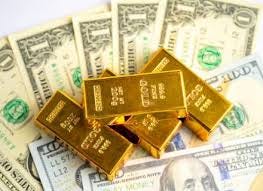Gold in International Finance
The rise in the price of gold signals the demise of the dollar-based international financial system


Andy Anderson explains why gold is displacing the US dollar as an alternative international currency and the implications for the pound sterling. The coming seismic changes to the international financial system should spur Scotland to ditch the weakening pound and replace it with its own sovereign currency that derives its value from the goods, services and natural resources in the Scottish economy.
In the book I wrote with Leah Gunn Barrett entitled “Collapse of the Pound Sterling – Protecting Scotland’s money,” we drew attention to the instability of the current international financial structure based on the US dollar with the pound sterling and the euro tied in as international currencies.
We explained the economic reason for this instability and why we were sure that the present system had no long-term viability, and would either gradually decline, or more likely suddenly collapse.
The foundation of our thinking was the economic principle that “wealth” or “real value” in economic terms is real goods & services or natural resources. Money, in whatever form it takes, has no intrinsic value, merely exchange-value in a market system. This is particularly true of fiat money, so any system where the money supply is consistently greater than the supply of goods & services or natural resources, is bound to fail in the long term.
The US, the UK, and the EU (Germany used to be an exception to this but no longer is), are persistently consuming more goods & services than they are producing. They are only able to do this because of an over-valued currency in international exchange. Such a log-jam in the economic system is like a temporary jam in the movement of tectonic plates. It holds things up for a while then there is an earthquake and the system lurches forwards as opposed to gradual slow movement.
The political log-jam, which was allowing the dollar and with it the pound sterling and the euro to maintain their high international trade value in spite of their negative trade balance with the rest of the world, was caused by US control of the international financial system and the lack of a suitable alternative. This situation couldn’t last indefinitely and was certain to be challenged.
One of the issues we did not pay enough attention to in our book, but which now needs to be taken into consideration, is the question of Gold as an alternative international currency or store of financial reserves.
Gold has a long history of being used in international trade as an exchange currency or money reserve for trading nations. When Sterling first became an acceptable international currency it adopted the gold standard. This meant that anyone, anywhere, could exchange their sterling for gold which the Bank of England would honour.
This sterling commitment was suspended during World War I and after a failed attempt to re-introduce it in the interwar years, it was abandoned after World War II.
However, this commitment to the Gold Standard was accepted by the US dollar when it took over as the main international currency after the war and sterling was relegated to a secondary position (later joined by the euro). So up until 1971 the dollar was on the gold standard and sterling was valued in relation to the dollar, to which it lost considerable ground.
When the US dollar came off the gold standard and the US Government continued to print more dollars than the goods & services it produced, we should expect that people might turn back to gold as a more stable and reliable currency for international trade, but this did not happen initially for 3 reasons:
(a) The US struck an agreement with OPEC to ensure that oil was sold all across the world in dollars only.
(b) The Western Institutional Investors (WII), who form a powerful force in international financial movements, had established useful institutions such as SWIFT which helped trading nations.
(c) The WII took control of world gold trading and were able to prevent Gold from being used to force down the exchange rate of the dollar to its real economic value.
In our book we dealt with (a) and (b) above, but not with (c), which is the subject of this paper.
If the US was printing more dollars than the goods & services it was producing, then the exchange value of the dollar in the international market should fall and gold, as an alternative medium of exchange, should rise relative to the dollar.
As we have noted, getting OPEC to sell all oil in dollars meant that all oil production in the world counted as US production to help balance the US trade deficit. But while helpful, this did not, by itself, fill the gap.
So the price of gold rose in international markets. In 1971 gold was priced at $35 per ounce. By 1980 it had risen to $850 per ounce. The US Federal Reserve Chairman, Paul Volcker, said, “Gold is my enemy,” when confronted with this pressure. However, he need not have worried. In the best tradition of American cowboy films, the US cavalry were on their way to deal with Volcker’s enemy.
In 1974 WII had set-up Gold Futures Trading, which led to a big rise in the unallocated (paper) Gold Market and countless gold derivatives emerged. If you want to offer people “options” when they want to buy gold, what’s better than a paper certificate giving them an entitlement to 10 ounces of gold that they can buy and put into their reserves. No actual gold changes hands, just paper, and today, not even paper but a digital record. This new method of owning gold was great for the banks and the big traders. They could do their trading from an office desk, no lifting and carrying heavy gold bars, no lorries or secure vaults required, just a paper transaction.
The system was designed just like the fractional reserve banking system and had the same flaw - only a “fraction” of the actual reserves exist, which can be a very small fraction. This means that many people who wanted to buy gold got a piece of paper claiming they were entitled to gold, but there was only a fraction of actual gold in the vault.
How much real gold exists relative to paper gold in Western banks today? No one knows for sure. 25 year ago it was estimated to be only 20%. Today it is estimated at 2%. This system dealt with Paul Volcker’s problem - the gold market was under control. When gold prices were on the rise, investors were sold paper gold or derivatives and these could be sold back when demand changed.
The pattern that emerged was that WII bought gold from the East in bull markets and sold gold to the East in bear markets. The buying from the west, controlled by institutional investors, was characterised by asset buying, while buying from the East was characterised by consumer demand.
This cyclical system operated effectively for many years and kept gold prices under control while the dollar, pound and euro retained their relatively high exchange rates while the US, UK and EU balance of trade positions worsened.
The February 2022 Russian invasion of Ukraine precipitated a change when the US illegally froze $300 billion in Russian central bank assets and is now threatening to seize them outright, undermining confidence in the dollar-denominated global financial system. Why would countries keep dollar-denominated foreign reserves when the US could seize them at any time? That same year the correlation between US dollar real rates and gold broke down and hasn’t been restored. In September 2022, gold prices rose as dollar rates remained flat. From October 2022 until June 2023 the price of gold rose 17%. So, what is happening to gold now?
In the trading of real gold, China and Russia are buying from the West and building up large reserves, while the paper gold is worthless.
It’s apparent to us that Russia and China, within the BRICS group of nations, are preparing for the development of a new international financial system to attract countries from all over the world to trade in a market that will more accurately reflect the real value of the dollar and with it, the pound and the euro.
This is already happening. As the new international financial architecture develops, it will spread across the international trading system, spelling the end of US hegemony in international finance with consequences for the pound sterling.




On the button again Leah. I read about Gold replacing the dollar a few months ago!!!
Yes, indeed.